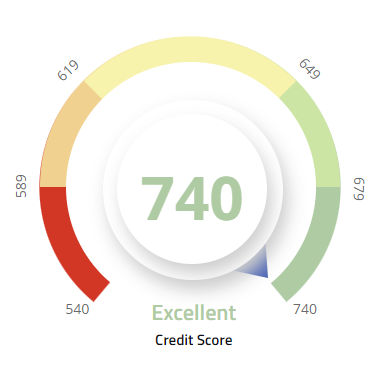- Your credit utilization rate consists of how much you currently owe divided by your credit limit
- This rate can impact your credit score
- A low credit utilization score shows lenders you’re using less of your credit and managing to keep spending in check
- The longer you use credit and the longer you take to bring the balance back to zero, the more you end up repaying
Revolving credit
Credit utilization rates are based on your credit cards and lines of credit. With this type of ‘revolving’ credit, there is no predetermined end date. The amount you owe carries over from month to month. Each month you can borrow against your credit limit and repay all or some of it and the end of the month.
As long as you don’t reach your credit limit, you can continue borrowing, paying interest on the amount you borrow every month. Paying your credit card balances in full every month means that you don’t accrue interest and your utilization of credit is low.
Debt-to-income ratio
Instalment loans factor into your debt-to-income ratio. Many home loan companies and auto loan lenders consider this ratio when making decisions, but it’s not used to calculate your credit score.
Per-card versus total utilisation
A per-card credit utilization rate compares the balance on an individual card to the credit limit on that card. If you have a credit limit of R20 000 on your card and you use R10 000, your credit utilization rate on that card is 50%. Your total utilization rate would compare your total credit card limits to your total credit use.
What is a good credit utilization rate?
A general rule is to use 30% or less of the credit available to you. It indicates to lenders that you’re not maxing out your credit cards. A high credit utilization rate could be a red flag to potential lenders, indicating you’re having trouble managing your finances.
Balance information
Your credit utilization rate – and by default your credit score – may be affected by when your credit card company updates your balance information. This information is usually updated every 30 days at the end of the billing cycle.
It is possible for you to make a payment on your credit card and not see the impact on your credit score for a few weeks until the credit card company updates the balance information.
Drawbacks of using credit
If you have too many credit cards, it can affect your creditworthiness and put off potential lenders. If you don’t manage your credit cards correctly, your debt can easily spiral out of control. You shouldn’t be using your credit cards to pay for food or other regular monthly living expenses. You should avoid using one form of credit to pay for another.
How to manage your credit utilization
- You need to learn how to make the way you utilize credit work for you and make you more creditworthy.
- Interest rates on credit cards tend to be high. Compare different offerings and choose those with the best rates.
- Pay your credit card balances in full every month or pay as much as you can instead of the minimum amount payable. Keeping your balances low means you avoid extra changes and move in the right direction.
- Having access to credit can help when you need short-term assistance and be beneficial when making online purchases. Faithfully paying the money back in good time helps you to build up a good credit history which is necessary if you want to make a big purchase, such as a house or a car.
- Check your credit card statements thoroughly and plan how and when you will bring them back to zero.
- Ask all your credit card providers about their credit life insurance policies. Many consumers don’t realize that insurance of credit can pay several months of debt repayments in the event of losing a job.
Your credit utilization rate affects your credit score. If you understand the way it works, you can manage it to make it work for you.

